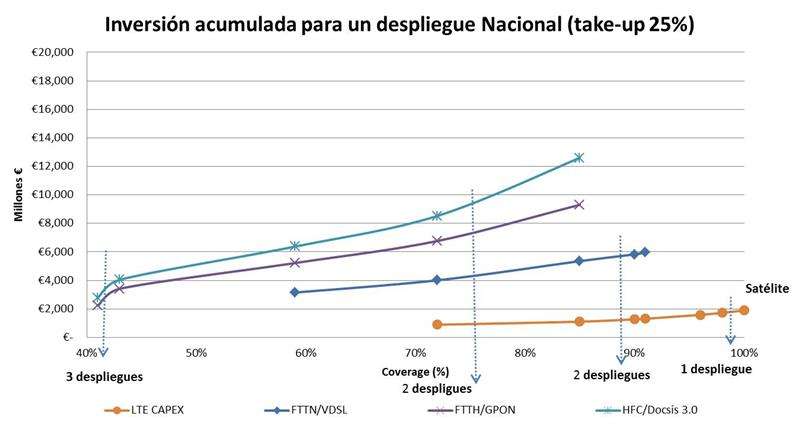What is the best solution to universalize 30 Mbps broadband?

Researchers from the Group of Information Technology and Communications at Universidad Politécnica de Madrid have carried out a techno-economic assessment to define the most cost-efficient technology to supply 30 Megabit per second broadband to municipalities with less than 5000 inhabitants. By using this so-called "rocket model," the research group has found that LTE (a standard for wireless communication) is the most suitable technology to ensure the investment return of rural areas in Spain.
The new goals of Digital Agenda for Europe regarding fast and ultra-fast broadband have led to search for the best strategy to achieve them. However, there is not a general consensus about what is the best technology to achieve the aim of providing 30 Mbps broadband to 100% of population.
The difficulty in rural areas lies both in socio-demographic characteristics of the population (low population density, low average income, elderly residents and low digital literacy) and geographical characteristics. The geographical issues involve technical problems with major economic consequences.
There are two strategies to confront these difficulties: the development of fixed networks or using mobile networks. Spain chose the second option by linking the coverage obligations on operators that were licensees of two blocks.
This obligation fell on Telefónica, Vodafone and Orange, which are bound to jointly provide 30 Mbps broadband to municipalities with less than 5000 inhabitants.
Once the strategy is selected, there is a need to assess the cost efficiency of the solution proposed by the Spanish government for the supply of 30 Mbps broadband of rural areas in Spain. Researchers at the School of Telecommunications Engineering of UPM have assessed the coverage obligations imposed on operators by the government in order to verify whether this imposed coverage leads to higher investment compared to the coverage required for a market deployment.
Likewise, researchers assessed the specific case of passive infrastructure sharing proposed by the Spanish government as a solution to for viable deployment in these areas. To do this, researchers have used the rocket model, a model used to assess the feasibility of deploying mobile networks in regional and European projects which has the support of the international scientific community.
The study has shown that LTE technology is the most cost-effective solution for 75% to 98.5% of population, since it is not expected that VDSL technology covers that region. In addition, satellite broadband is recommended to cover the last 1.5% of population.
It was confirmed that these commitments are acceptable for operators since they do not exceed the annual investment trend of previous years. However, operators do not have enough incentives to invest in rural areas because the adoption service seems to be very low. The passive infrastructure sharing is an effective tool to reduce costs. But the deployment feasibility depends, on a higher degree, on the service adoption. Therefore, additional measures are required in order to ensure the investment return in rural areas. These measures aim to stimulate demand and reduce the number of deployed networks.
More information: "LTE techno-economic assessment: The case of rural areas in Spain". Telecommunications Policy, 39(3): 269-283. DOI: 10.1016/j.telpol.2014.11.004
Provided by Universidad Politécnica de Madrid



















